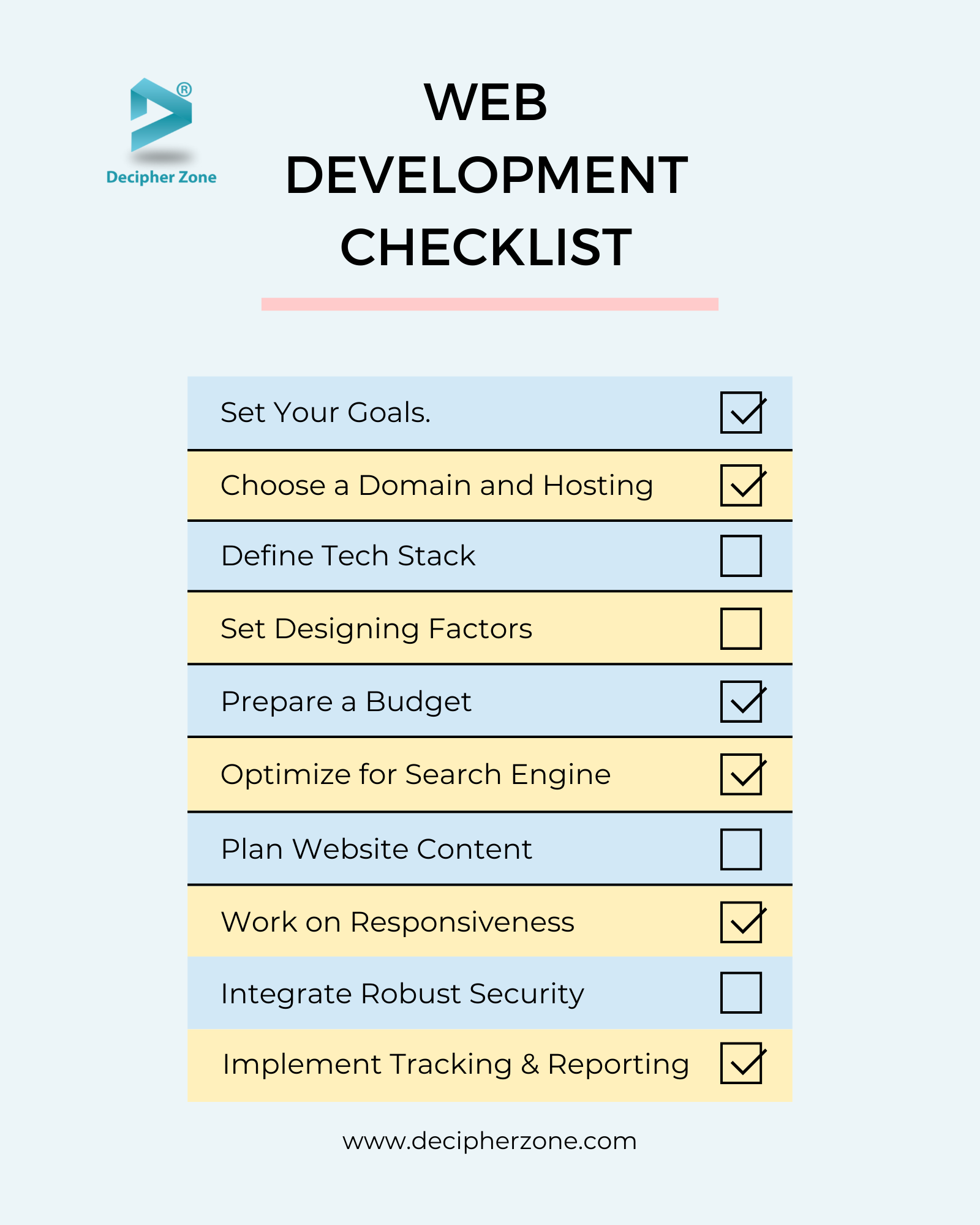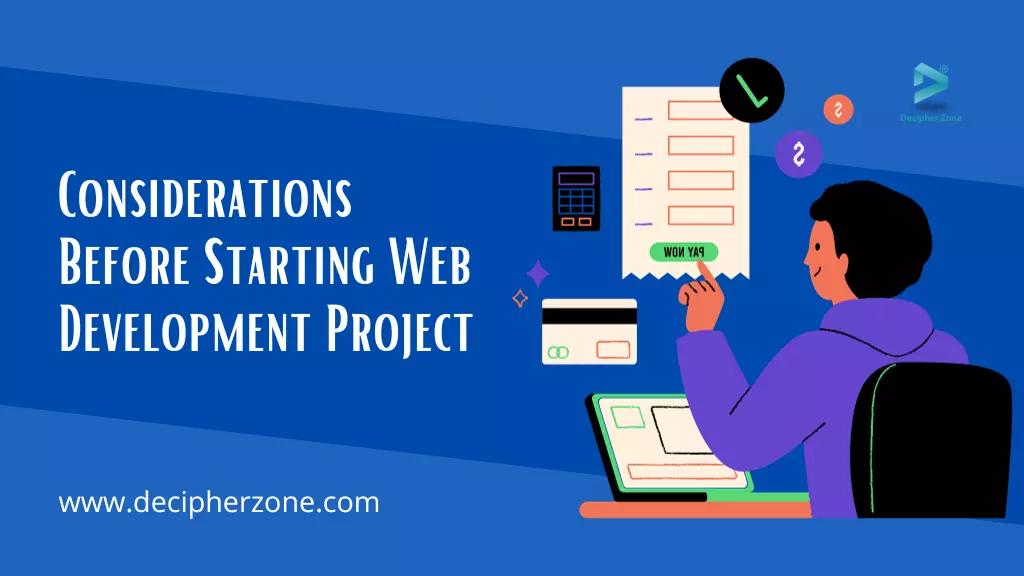Top 10 Considerations or Checklists Before Starting Your Web Development Project. Are you planning to redesign your website or build a new one that meets the requirements of today’s fast-paced business era? But do you know what are the things you need to consider before getting started with your web development project? This article will help you understand what crafting a website entails and the pivotal requirements to develop a successful one.
Understanding Web Development
Web development, or website development, encompasses numerous tasks involved in creating, designing, and maintaining interactive web applications and websites accessed through a browser. Web development includes everything from creating the initial concept and design to writing and testing the code, along with ongoing maintenance and updates.
Web developers use various programming languages, tools, and frameworks to build responsive, user-friendly, and visually appealing websites that adapt to different screen sizes and devices. The role of web development is crucial to building a substantial online presence, showcasing products or services, and designing dynamic and interactive interactions between businesses and users.
Top 10 Web Development Checklists For Your Project
Crafting a website is a complex process and requires a lot of detailed planning. That’s why we have enlisted the top 10 major considerations you need to do before working on a web development project.
-
Setting Your Goals
-
Choosing a Domain and Hosting
-
Define Tech Stack
-
Setting Designing Factors
-
Prepare a Budget for Development
-
Optimize for Search Engine
-
Plan Website Content
-
Work on Responsiveness
-
Robust Security
-
Tracking & Reporting
1. Setting Your Goals
If you want to create a stellar website for your business you need to plan and set clear goals. You can start by determining if you want to increase revenue, improve customer satisfaction, reduce personal work hours, or showcase your service or portfolio. Also, make sure to keep your website goals S.M.A.R.T.E.R, i.e., Specific, Measurable, Achievable, Relevant, Time Sensitive, Evaluated, and Reviewed.
2. Choosing a Domain and Hosting
To succeed online, a good domain name is important. It should be easy to remember and spell while reflecting your brand, helping you show up in search results. On the other hand, when choosing a hosting package, you need to consider your site's needs, traffic, and features like support, backup, and security.
3. Define Tech Stack
It is impossible to create an interactive website without the right tech stack, making it essential to choose the right set of technologies for the front end and back end of the website. This will include choosing the right programming language, framework, web server, database, and operating system.
For instance, if your website needs to handle a high volume of traffic and data, it is vital to select a technology stack that possesses potent back-end support. Conversely, if you require a website that performs exceptionally fast with limited resources and functionality, it is advisable to choose a technology stack that is lightweight and easy to set up.
4. Setting Designing Factors
One of the biggest requirements you should consider before starting web development is its design. If you want to provide a good user experience that helps build a customer base then carefully about the website colors, text font, navigation, mobile-friendliness, call-to-action buttons, usability, accessibility, clean design, functionality, etc.
5. Prepare a Budget for Development
Setting a budget for the project can be the most difficult part of web development. You must know how much you are willing to spend on a minimum viable product (MVP) and a full website version. Don’t forget to include licensing and infrastructure costs in the calculation. Another thing to remember here is that the web development will not end after the website launch, instead, you will have to continuously work towards website improvement over some time to fix any minor or major issues, ensuring that users get a smoother experience.

6. Optimize for Search Engine
SEO can be quite challenging to get right on the first try. However, it is crucial to ensure that you have addressed as many search engine optimization factors as possible. Optimizing SEO of the website consists of backlinking, keyword research, alt texts, responsiveness, unique pages, structured data markup, meta description, heading tags, and regular content updates.
7. Plan Website Content
Content can be the maker or breaker of the website’s traffic. Therefore, you need to keep the content of the website written before creating the website. To plan the content of the website accurately you must define the purpose of the content, draft a headline, write copy, add images and videos, optimize the content assets, implement SEO in the content, promote the content, and maintain it.
8. Work on Responsiveness
With more and more users moving towards mobile devices for web surfing, it is vital to create a website that is responsive for tablets and smartphones. Designing the website for mobile devices means that the icons, images, menus, videos, and paragraph structure can easily adapt to the screen it is being used on and work with the touch interface.
9. Robust Security
With the continuous growth of technology, new and advanced security risks are also arising that can compromise the security of your website. To overcome these cyber threats, it is essential to add robust security through SSL certificates and two-factor authentication. Other than that you can also update third-party services, consider email captcha, use secure hosting, and keep your website updated by fixing bugs and errors.
10. Tracking & Reporting
You should also integrate tracking and reporting tools into your website like Google Analytics, Bing Webmaster, or Google Webmaster. These tools allow businesses to monitor traffic, conversion rates, and customer engagement on different devices. This enables you to discover the best-performing market campaigns or blogs. With the help of these insights, you will be able to improve the marketing and engagement strategies of the website to maximize ROI.
Conclusion
By now you might have a clear idea of how many web development requirements you need to consider to keep your website up and running for a long time. And, if you are seeking a seasoned team of web developers for your website development project, then contact our experts now! We will evaluate your requirements and offer you a personalized quote for a customized web development solution that will lead you to success.
FAQs: Web Development Checklists
What to consider before developing a website?
A few considerations before developing a website are:
-
Setting Your Goals
-
Choosing a Domain and Hosting
-
Define Tech Stack
-
Setting Designing Factors
-
Prepare a Budget for Development
-
Optimize for Search Engine
-
Plan Website Content
-
Work on Responsiveness
-
Robust Security
-
Tracking & Reporting
What are the five stages of website development?
The five development stages of a website include designing, coding, testing, debugging, and maintenance.
What is the cost of web development?
Web development can cost anywhere from $15,000 to $250,000 depending on the features, complexity, size, domain, type, and development team region.

